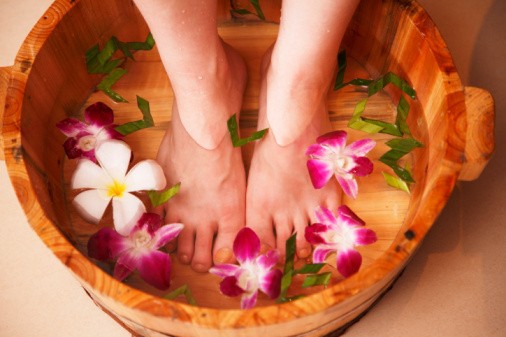Diabetes can mean Double Trouble for your feet. Firstly, diabetes, reduces blood flow to the feet, legs prepare oxygen and nutrients. This makes it difficult for blisters, wounds and wound healing. And secondly, damage, called diabetic neuropathy, peripheral neuropathy can cause numbness in the legs. If you can not feel cuts and blisters, is more likely to get ulcers and infections.
If you do not see or treat injuries, they can become severely infected and lead to amputation. The sad reality: the fingers, legs, feet or less, surgery is 10 times more likely in people with diabetes.
Diabetic peripheral neuropathy can also cause a sharp pain in the legs. These may be particularly sensitive to light touch, such as bed linen Anda.Untungnya, a little TLC goes a long way in preventing foot problems due to diabetes.
10 tips to protect your feet
First Check both feet every day.
Look at both feet carefully every day, and be sure to check between all fingers. Blisters and infections can start between the toes, and diabetic neuropathy, you can feel until they become irritated or infected. If the physical problems you examine your own feet, ask family members to help.
Second Wash with warm - not hot water.
Wash your feet every day with a short warm - water - not hot. This may not be able to feel heat on your feet, so test the water with your hands. Avoid soaking too long in the water because the water-filled wound healing time was harder. Dry feet soon, and remember to dry slightly between all fingers.
Third Make sure your shoes fit.
It's worth the investment. Even the slightest rubbing or misfit shoe can cause blisters that turn into infected wounds, and it never heals. Buy better-fitting shoes, or try different socks, even signs of redness or irritation of the smallest, because probably not feel it when it gets worse. Before buying or wearing shoes check shoes for rough seams, sharp edges or other objects that could damage the legs. And gradually the rest of the shoe.
4th Avoid shoes at home.
Always wear shoes or sandals. Always wear socks with shoes is leather, plastics and synthetic materials, the shoes can irritate skin and cause blisters quickly. Although you can choose the appearance of the hose, nylon knee, or thin socks, you may find that it gives the toes or heels sufficient protection. Wear thick socks to pad your feet and cushion any calluses and sores.
5th To speak.
Nerve damage can be predicted. Tell your doctor about any changes in sensation in the fingers, feet or legs. Talk when you feel pain, numbness, feeling of pins-and-needles, numbness, or other unusual symptoms - even if it seems trivial to you. No small potatoes for a possible amputation.
6th It remains soft - but dry.
Your skin may be dry and cracked due to high glucose levels, and the chapped skin means that it is easier for bacteria to get under the skin, and it is difficult to treat infection. Use a small amount of lotion daily, but make sure that your feet feel dry - not wet or sticky - after that. Try to get the milk away. Keep nails neat and filed smooth to prevent ingrown nails. You can easily cut nails after application of cream, while cuticles soft. Use a pumice stone after bathing or showering to submit a soft corn or calluses.
7th Try exercise.
Swimming, cycling, yoga and Tai Chi is increasingly popular exercise - with minimal impact on its feet. Consult your doctor before starting an exercise program.
8th Fix bunions, corns, and hammertoes.
When suddenly standing over your fingers on the other hand, with a large bulge on the knuckle of thumb, you have a blister classic. Maize is a thick skin, rough, if the tissue is formed at the foot still too bombard rubbing or pressure. Curved, lower leg, known as hammertoe, can lead to muscle weakness caused by diabetic nerve damage. That makes it difficult to adapt to comfortable shoes. But a good podiatrist can help you solve this problem and take care of your feet better.
Tip 9th Consider fitted with prosthetics.
Podiatrist can fit you with orthotics inserts called to support the foot, if you have diabetic nerve pain and muscle becomes weak from nerve damage. If the pain or weakness so severe that it is too painful or even impossible to walk, leg braces and orthopedic shoes can help. Podiatrist is the best source for this device.
10th Control of blood sugar.
The best treatment for nerve pain, eventually to manage diabetes properly. In fact, a large study of the American Diabetes Association in 2006 showed that tight blood glucose levels with intensive insulin therapy reduces the likelihood of symptoms of peripheral neuropathy - tingling, burning and pain - 64%. Although it can not control whether or not you have diabetic neuropathy pain, you can help control blood glucose levels with diet, exercise and mediation, if you need it.
